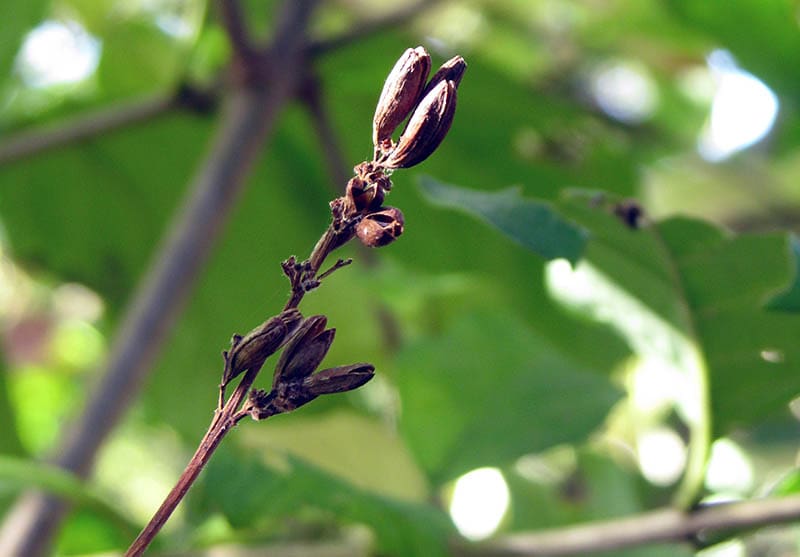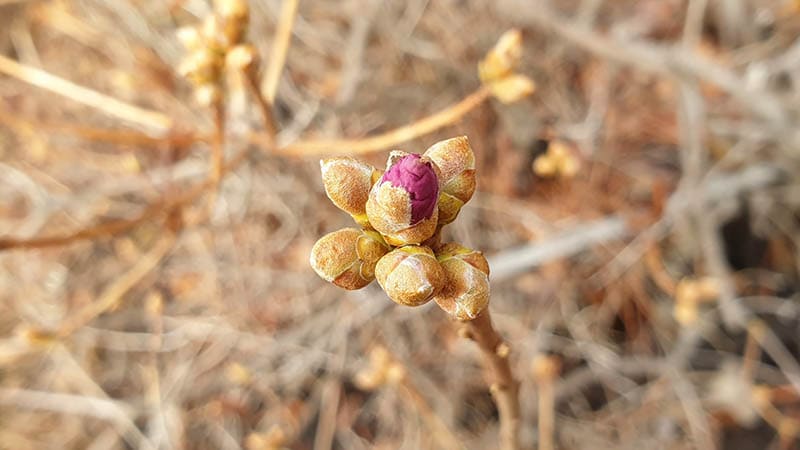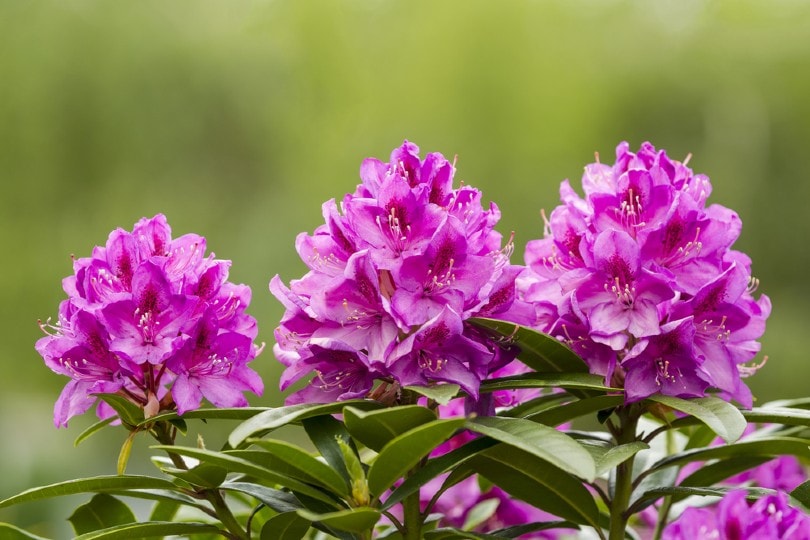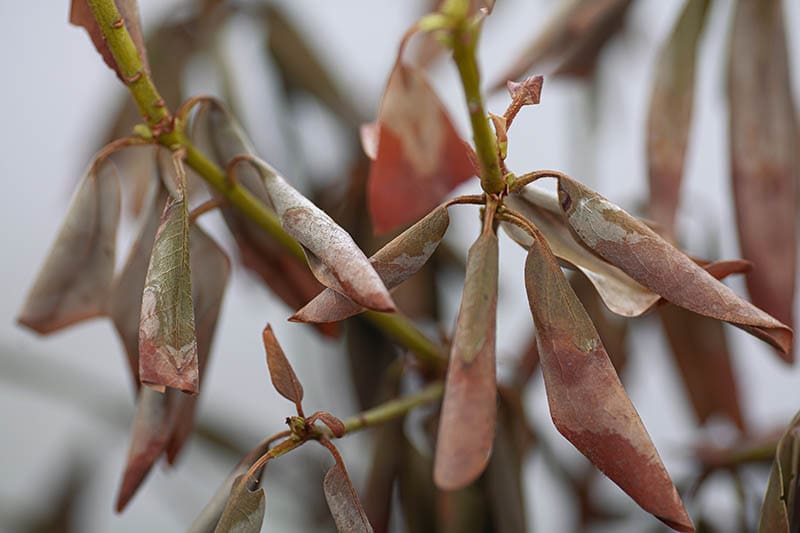Is My Rhododendron Dead (4 Signs to Look For)
-
Pete Ortiz
- Last updated:

As the proud owner of a rhododendron, you have probably experienced the bittersweet feeling of watching your beloved plant slowly wilt away. Even though it’s one of the hardiest plants around, there are still some signs to look for that can tell you if your rhododendron is on its last legs.
Here’s a quick guide of four telltale signs to help you determine whether your rhododendron has gone to that big garden in the sky. Be sure to stick around till the end to learn some helpful tips for keeping your rhododendron in tip-top shape. Let’s get started!
The 4 signs to Determine if Your Rhododendron is Dead
1. Green Flesh Under Bark

By doing a simple scratch test, you can easily determine if your rhododendron is still alive. Carefully scratch away some of the outer bark with your fingernail and look for green flesh. If you find any, your plant is still alive.
But if there is no green, then it could be a sign that the rhododendron is dead. Green flesh means there is still moisture, which is a clear telltale sign that your plant still has life in it. Moisture is vital to any plant’s survival, and if there is none, your plant will not be able to pull through.
2. Brown Flesh
Just as green flesh means your rhododendron is still alive, brown flesh signals that it has passed away. While green flesh underneath the bark means there is moisture in the plant, brown flesh indicates that all the moisture has been removed from it.
This is a surefire sign that your rhododendron is not coming back to life, no matter what you do. While this is an incredibly sad thing, at least now you can remove the remaining plant and replace it with another one.
3. New Shoots

A healthy, living rhododendron will continue to develop new shoots. If you notice any new buds, leaves, or branches growing from your rhododendron, then it’s a clear sign that your plant is still alive and kicking!
The stems of a living rhododendron are also typically bright green and healthy looking. If your rhododendron looks like it’s in poor condition or it has begun to wilt and die, then it could be a sign that the plant is not long for this world.
If you determine that your plant is still alive, but there are old, dead branches present, you should prune them off. Pruning will help to stimulate new growth and keep your rhododendron healthy.
4. No Shoots
A lack of shoots or new branches is a dead giveaway that your rhododendron is not in the best of health. If you haven’t noticed any new growth in quite some time, then it’s likely that your plant has already died.
In addition to a lack of new growth, you may also notice a few other signs that your rhododendron is dead. These include yellowing leaves, wilting stems, and a general lack of foliage.
Tips for Healthy Rhododendron Growth
Now that you know what to look for to determine if your rhododendron is dead or alive, let’s talk about how to keep it healthy.

Acidity and Shade
Rhododendrons thrive in acidic soil and partial shade. If you can find a spot with these conditions for your plant, then you’re off to a good start! You should also water the plant regularly but don’t oversaturate the ground; too much moisture can cause root rot.
Fertilization
Fertilizing is important, as well, so use an acidifying fertilizer like cottonseed meal or bark mulch every few weeks during its growing season (spring). You’ll want to make sure you prune the plant in late winter, too.
Pruning
As touched on previously, pruning is essential for maintaining a healthy rhododendron. You want to cut off any dead or diseased branches, as well as those that are crossing each other and competing for sunlight.
Pests and Diseases
It’s also important to be aware of pests and diseases that can affect your rhododendron. Spider mites, aphids, scale insects, and leaf miners are all common problems. Keeping an eye out for these critters is key to keeping your plant healthy!
Additionally, bacterial or fungal diseases, such as leaf spots or powdery mildew, can occur if the environment isn’t ideal. This is why it’s so important to ensure your rhododendron is in the right environment.
The attentive care of your rhododendrons will go a long way in ensuring they remain healthy and vibrant! With the right conditions, your rhododendrons should be thriving for years to come.
Common Causes of Death in Rhododendrons

Rhododendrons are beautiful and can make a great addition to your garden. Unfortunately, death is sometimes a reality for your beloved rhododendrons. There are a few common causes of death in rhododendrons that you should be aware of:
Not Enough Water
Rhododendrons need to be watered regularly to stay healthy. If they don’t get enough water, their leaves will start to turn brown, and they will eventually die. What’s more, if you don’t water your rhododendron deep enough, its roots won’t be able to access the nutrients they need to thrive.
Too Much Cold
Rhododendrons are not able to survive in temperatures lower than -35°F. While most plant owners won’t have to worry about this, those who live in regions with cold winters should take extra care to protect their rhododendrons during the colder months. Additionally, sudden drops in temperature can also be harmful to your plant if not monitored closely.
Pest Infestation
Pests can wreak havoc on your garden, and rhododendrons are no exception. If you notice webbing or other signs of pests on your rhododendrons, act quickly to get rid of them before they spread to other plants.
You should also make it a point to monitor your rhododendrons for any signs of unusual damage or wilting that could indicate a pest infestation.
Disease
Like all plants, rhododendrons can be susceptible to disease. Make sure to keep an eye out for any signs of wilting or discoloration that could indicate the presence of a fungal or bacterial infection.
If you determine that there is a disease present, you should act quickly to treat it. In many cases, prompt action and proper care can help your rhododendrons bounce back.
Too Much Water
Too much water can be just as damaging to rhododendrons as not enough. Overwatering your plants can lead to root rot and other issues, so make sure to monitor the amount of water you are giving your rhododendrons.
Soils with poor drainage can cause waterlogged soil, which can quickly kill a rhododendron. Consider planting your rhododendrons in raised beds to help promote better drainage or use a mixture of compost and other organic material to improve the soil’s ability to drain water.
By keeping an eye out for any of these signs, you can prevent an untimely death for your rhododendrons and keep your garden looking beautiful!
Conclusion
Although rhododendrons are strong shrubs, they can still succumb to death without proper care. To determine if your rhododendron is dead, observe the warning signs listed above.
Taking optimal steps for nurturing and maintaining a healthy environment will help promote its longevity! If you show it love, your beloved plant can thrive in splendid glory for years and years to come.
Featured Image Credit: Eric Buermeyer, Shutterstock
Contents



